Your roof faces a constant battle with the elements. Understanding this relationship is crucial if you want to protect your home.
From scorching summer sun to heavy winter snow, each weather condition brings its own threats to your roof’s integrity and lifespan.
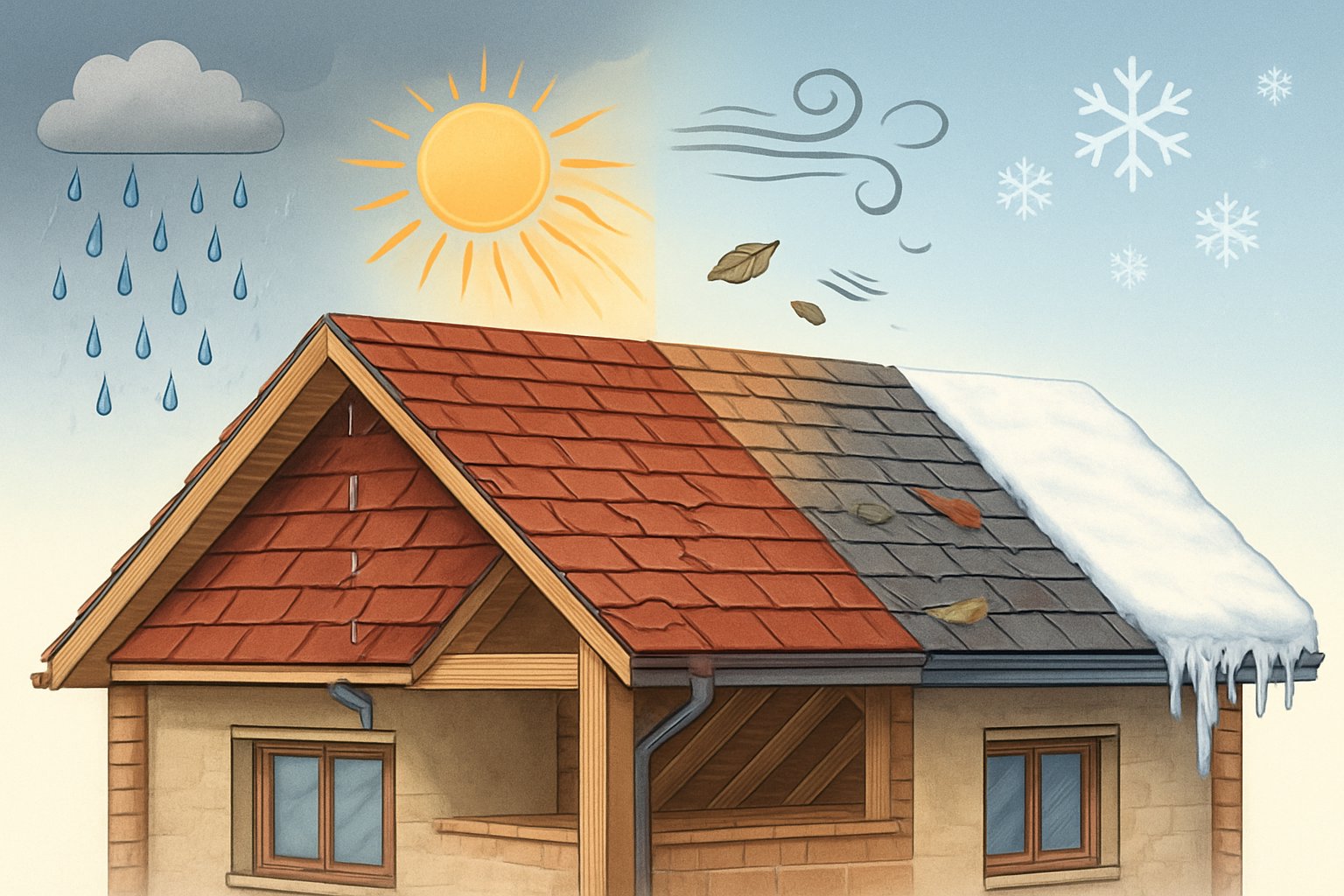
Weather impacts every roofing material differently, causing problems like UV damage, water leaks, wind uplift, and ice dams that can lead to costly repairs if left unchecked. The good news? You can take steps to minimize weather-related damage and keep your roof in good shape for years.
This guide digs into how different weather conditions affect your roof. You’ll also get practical solutions to help protect your investment.
Need a Home Fix – Emergency or Routine?
From leaks and no-heat nights to simple tune-ups, our 24/7 hotline connects you with trusted local pros in minutes.
By spotting warning signs early and keeping up with maintenance, you can avoid those small headaches turning into big, expensive problems.
Key Takeaways
- Different weather conditions cause specific types of roof damage, from UV rays that make shingles brittle to ice dams that force water under roofing materials.
- Regular inspections and simple maintenance—like cleaning gutters and checking flashing—can prevent most weather-related roof problems.
- Using materials suited for your climate and making sure your roof is well-ventilated helps it stand up to local weather challenges.
Understanding How Weather Affects Your Roof
Weather puts constant stress on your roof through temperature swings, moisture exposure, and physical impacts. Different roofing materials react in their own ways, and certain damage patterns show up after long-term exposure.
The Role of Roofing Materials in Weather Resistance
Asphalt shingles are the most common, but they struggle with UV radiation. Sun dries them out and makes them brittle.
Metal roofing handles wind and reflects heat well. It expands and contracts with temperature changes, but honestly, it handles that better than most other options.
Clay and concrete tiles resist fire and UV damage, but they can crack in freeze-thaw cycles. Their weight means your roof structure needs to be solid.
Wood shingles soak up moisture and can get moldy or rot if neglected. They need regular treatment to stay weather-resistant.
Slate roofing lasts for decades, but hail can crack individual tiles. Flat roof membranes like EPDM rubber or TPO are better at dealing with ponding water, but only if drainage is good.
Types of Roof Damage Caused by Weather
Wind damage shows up as lifted, torn, or missing shingles. Strong gusts can send debris crashing into your roof, causing punctures or cracks.
Rain is the most common culprit for roof damage, usually through water infiltration. Missing or damaged flashing lets water sneak in, and clogged gutters can create ice dams that force water under shingles.
Hail leaves dents, cracks, or strips granules off asphalt shingles. Big hailstones can even punch right through some materials.
Snow adds weight that stresses your roof. Ice can crack materials as it expands, and freeze-thaw cycles slowly wear things down.
UV rays gradually break down organic materials in shingles. Temperature swings cause your roof to expand and contract, which loosens fasteners and creates gaps.
Common Signs of Weather-Related Roof Problems
Water stains on ceilings or walls usually mean you’ve got a roof leak. These often pop up after heavy rain or melting snow.
Granules from asphalt shingles might show up as bare spots or collect in gutters. That leaves the underlying material exposed and vulnerable.
Curled or cracked shingles point to UV and heat damage. Once they curl, they can’t shed water properly.
Missing or damaged flashing looks like gaps or rust around roof penetrations. Water can easily slip through these spots.
Sagging areas often mean structural damage from too much snow or water. Ice dams can show up as thick ice at the roof’s edge.
Moss or algae growth means moisture is sticking around. This stuff can lift shingles and trap even more water underneath.
Sun and Heat: How UV Rays Impact Roof Longevity
UV rays break down roofing materials at the molecular level, making them brittle and shortening their lifespan. Some materials handle sun better than others, but none are invincible.
Recognizing Sun Damage on Roofing Surfaces
Sun damage creeps up slowly, so it’s tough to spot early. UV rays cause chemical changes that quietly weaken your roof.
Asphalt shingles lose their protective granules, which end up in your gutters. Once those are gone, the asphalt underneath takes the full brunt of the sun.
Shingles curl at the edges when heat evaporates their oils. Cracks form as the material gets brittle. You’ll often see color fading in blotchy patches.
Other materials have their own issues. Wood shakes warp and shrink in extreme heat. Clay tiles can crack from all the heating and cooling.
Metal roofs might show paint fading or a chalky surface. Flat roof membranes can blister or bubble from UV exposure. Cracks in sealant around vents and chimneys are also signs of sun damage.
It’s smart to check your roof twice a year for these problems. Catching issues early can save you a lot of money and stress later.
Choosing UV-Resistant Roofing Materials
Some roofing materials stand up to the sun better than others. If you live somewhere hot, it’s worth choosing wisely.
Metal roofing with the right coatings offers great UV resistance. A good metal roof can last 40-70 years, even under constant sun. Lighter colors reflect more heat.
Class 4 asphalt shingles have UV stabilizers that slow down breakdown. These usually last 25-35 years, compared to 15-25 for standard shingles.
TPO and PVC membranes are solid picks for flat roofs. White membranes reflect sunlight and can last 20-30 years. Heat-welded seams are less likely to fail than adhesive ones.
| Material | UV Resistance | Typical Lifespan |
|---|---|---|
| Metal (coated) | High | 40-70 years |
| Class 4 Asphalt | Moderate-High | 25-35 years |
| TPO/PVC Membrane | High | 20-30 years |
| Standard Asphalt | Low | 15-25 years |
You can also add reflective coatings to your existing roof for extra UV protection. These coatings can lower roof temperatures by up to 60°F and help your roof last longer.
Rain and Water Damage: Protecting Against Moisture Infiltration
Heavy rain is probably your roof’s biggest enemy. Water finds its way through weak spots and overloaded drainage systems in no time.
Keeping gutters clear and fixing damaged materials fast gives you the best shot at avoiding expensive water damage.
Preventing Leaks from Heavy Rain
Proper drainage is your first defense against rain. Water should run off quickly, not pool or back up.
Check your roof’s slope. Flat spots or dips let water collect, which puts pressure on your roofing materials.
Missing or loose shingles let water in during storms. Even small gaps can lead to big leaks.
After a storm, walk around and look for:
- Lifted shingle edges
- Cracked or split materials
- Exposed nail heads
- Damaged flashing around vents and chimneys
Ice and water barriers add extra protection in the spots that need it most. These self-sealing membranes keep water off your roof deck, even if shingles fail.
It’s worth having a pro make sure these are installed right, especially along the edges, valleys, and anywhere water tends to sneak in.
The Importance of Gutter Maintenance
Clogged gutters make water spill over and sneak under your roof edges. This can damage your roof and even your home’s foundation.
Leaves, twigs, and shingle granules clog up the works. In heavy rain, gutters can’t keep up if they’re full of debris.
Regular cleaning solves most gutter issues. Clean them at least twice a year, and after big storms if you can.
When you’re cleaning, be sure to:
- Clear out all debris from gutters and downspouts
- Check slope toward the drains
- Inspect attachments and brackets
- Test water flow next time it rains
Damaged gutters need quick attention. Sagging, loose joints, or holes let water escape before it reaches the ground.
Getting a pro to repair your gutters makes sure water flows away from your roof—and keeps your home dry.
How Damaged Shingles Lead to Water Issues
Compromised shingles can’t shed water like they’re supposed to. Cracks, curled edges, and missing granules all give water a way in.
As shingles age, they get brittle and develop tiny openings that get worse over time. Storms speed up the process—hail makes impact points, and wind can rip shingles right off.
Even small shingle damage deserves fast repair. Otherwise, the next heavy rain could turn it into a major leak.
Proper shingle replacement restores your roof’s ability to shed water. New shingles need to match your roof’s specs and be installed correctly.
When a pro handles repairs, you get proper overlap, sealing, and integration with the rest of your roof. That keeps water out and helps your roof last longer.
Wind Damage and Storm Preparedness
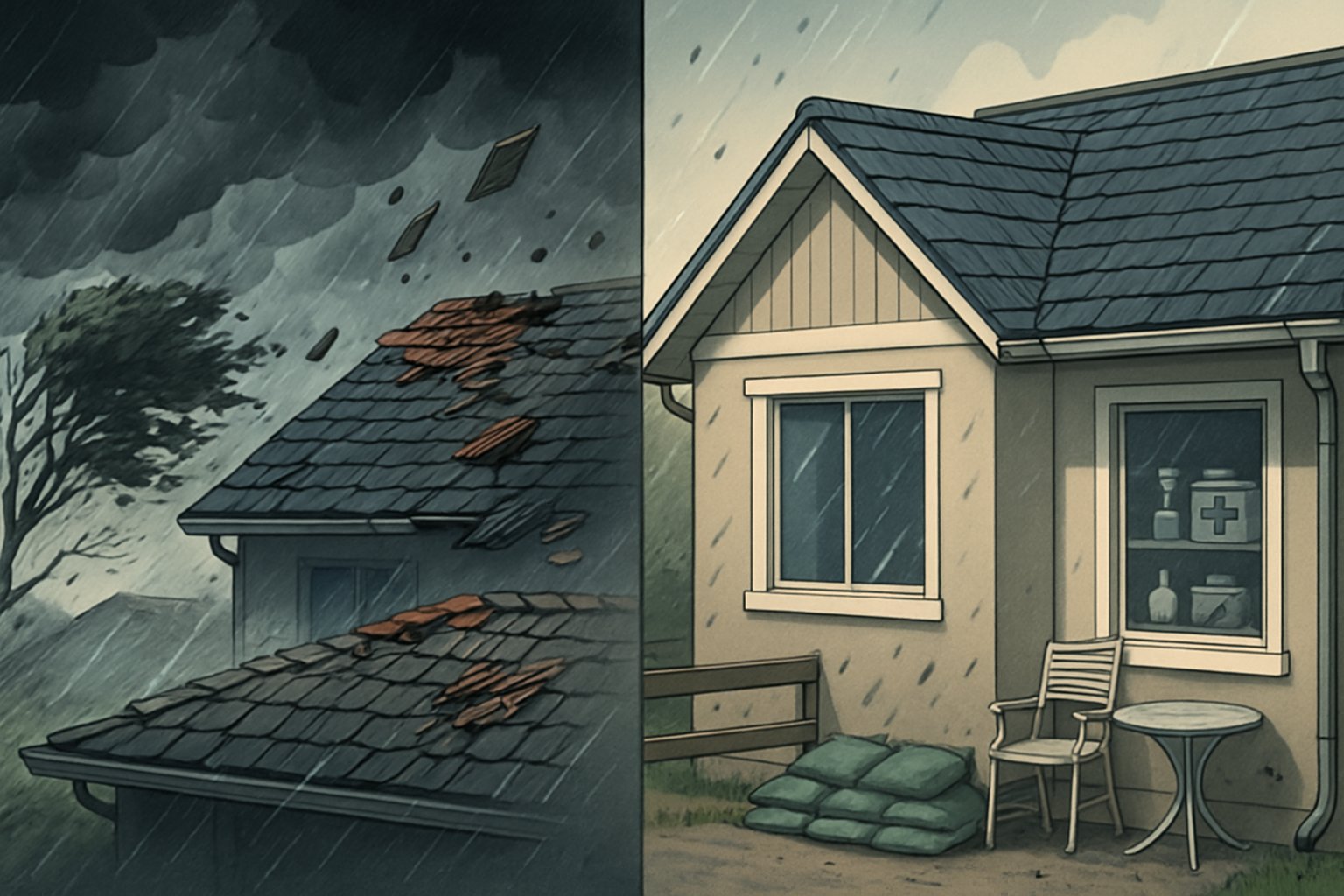
High winds put a ton of stress on roofing systems, especially from uplift forces and flying debris. Using the right materials and taking a few precautions can actually save you from some pretty expensive wind damage.
How High Winds Affect Roof Structure
Wind creates uplift pressure that tugs at shingles and roofing from underneath. The edges, corners, and peaks of a roof usually take the worst of it, since the air pressure changes so quickly there.
Winds over 50 mph can lift up loose or damaged shingles. If the roof’s already compromised, even well-installed materials might tear away in 70+ mph gusts.
Common wind damage patterns include:
- Shingle loss starting at roof edges
- Lifted or curled shingle tabs
- Exposed roof deck areas
- Damaged flashing around vents and chimneys
Older roofs with worn fasteners are just easier targets for the wind. Missing or loose nails give wind a way in under your shingles.
Gabled roofs tend to get hit harder than hip roofs. Those flat gable ends catch the wind like sails—never a good thing for your roof.
Impact-Resistant Shingles for Windy Climates
Impact-resistant shingles use reinforced materials to handle both wind uplift and debris. Shingles get rated from Class 1 up to Class 4, with Class 4 being the toughest.
Key features of wind-resistant shingles:
- Reinforced backing materials
- Enhanced adhesive strips
- Stronger fastening systems
- Improved granule retention
Class 3 and 4 shingles can take hits from hail up to 1.75 inches. They also stick better in high winds than regular shingles.
Insurance companies often give discounts for impact-resistant materials. That can knock 10-20% off your installation costs over the years.
Install wind-resistant shingles with the right technique. Six nails per shingle, not four, gives you way more holding power in storm-prone regions.
Steps to Prevent Wind-Related Roof Damage
Regular inspections help you spot loose materials before the storms show up. Look for lifted shingles, exposed nails, and busted flashing at least twice a year.
Pre-storm checklist:
- Secure loose shingles with roofing cement
- Replace missing or damaged flashing
- Trim tree branches within 10 feet of the roof
- Clean gutters to prevent water backup
Add extra fasteners in the most vulnerable spots, using hardware rated for wind uplift. Hurricane clips and straps make the roof-to-frame connection much stronger.
Take down or secure satellite dishes, antennas, and anything else mounted on the roof. Those things can fly off or create stress points in a windstorm.
After a storm, check your roof from the ground using binoculars. Look for missing shingles, exposed decking, or debris damage before you even think about climbing up there.
Snow, Ice, and Hail: Cold Weather Roofing Risks
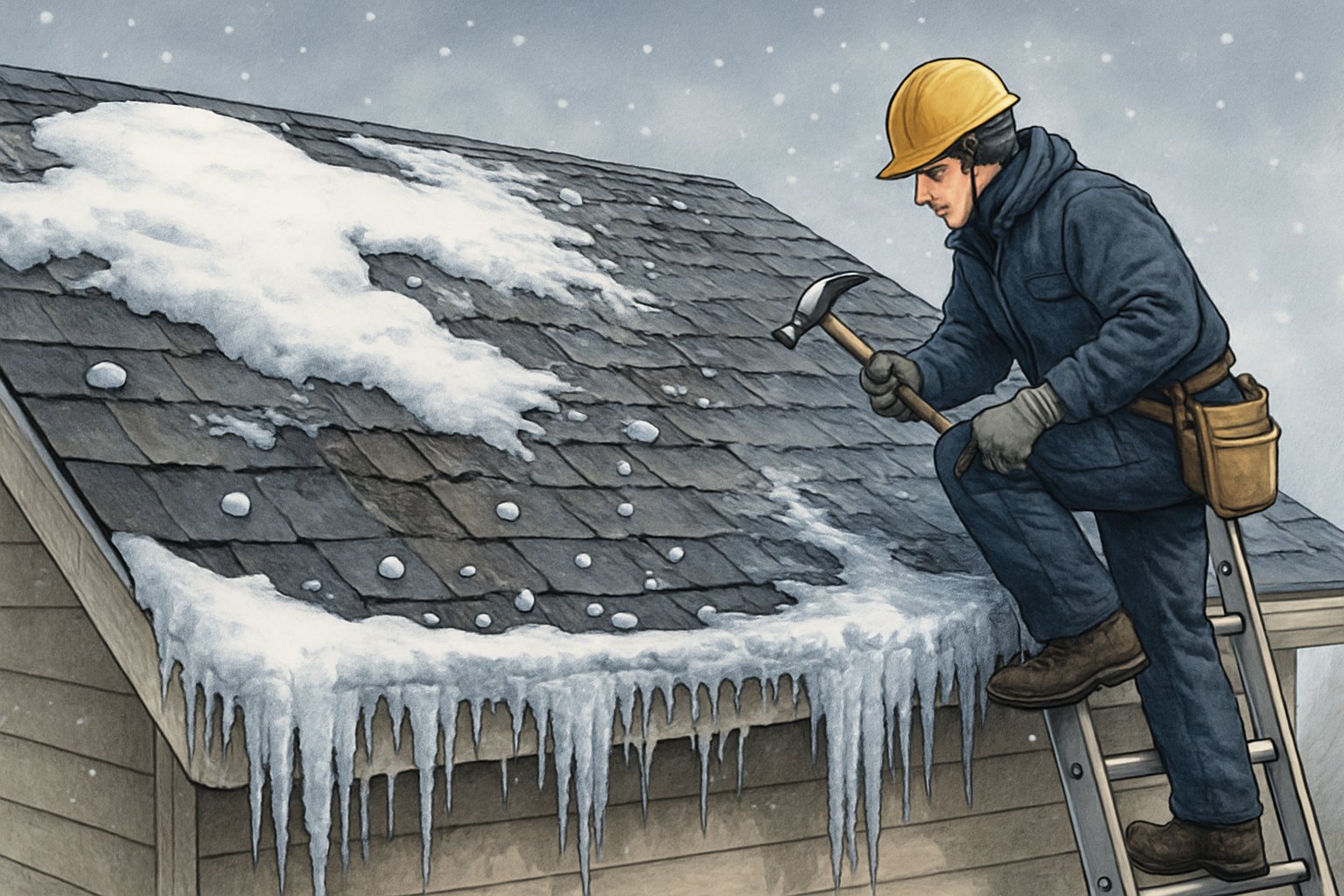
Winter brings its own headaches for homeowners. Snow piles up on roofs, ice dams clog up gutters, and hail can smash shingles in seconds.
All that can mean leaks, structural damage, and repair bills nobody wants.
Ice Dams and Their Consequences
Ice dams form when snow melts higher up on the roof and then refreezes at the colder eaves. You end up with a ridge of ice that stops water from draining right.
Poor attic insulation lets heat escape, melting the snow unevenly. Water gets trapped behind the ice dam and sneaks under your shingles.
Common ice dam problems include:
- Water damage in attics and ceilings
- Mold growth from moisture buildup
- Damaged insulation and drywall
- Loose or cracked shingles
Most ice dams can be avoided with good attic insulation and ventilation. Sealing air leaks and keeping insulation consistent helps keep roof temps even.
Heat cables along the roof edge can help too, especially if you get a lot of snow. They melt the snow before it can freeze into a dam.
Hail Damage: Identification and Prevention
Hail damage usually shows up as dents, cracks, or missing granules on your shingles. Big hailstones can punch right through roofing and open up the structure to leaks.
Signs of hail damage include:
- Bruised or cracked shingles
- Exposed roof deck
- Dented gutters and downspouts
- Granules in gutters after storms
Impact-resistant shingles stand up better to hail. They meet strict testing standards and could help you get a break on your insurance.
Check your roof after hailstorms, even if you can’t see much from the ground. Sometimes you need a pro to spot hidden damage.
Fix hail damage fast. Even small issues can let water in and turn into much bigger headaches later.
Winter Maintenance for Roof Protection
Staying on top of winter maintenance goes a long way. Clean gutters before winter so melting snow can drain off.
Essential winter maintenance tasks:
- Remove debris from gutters and downspouts
- Trim overhanging tree branches
- Check for loose or damaged shingles
- Ensure proper attic ventilation
Clearing snow off your roof keeps the weight down. If you don’t want to risk it, hire a pro—it’s safer and worth it.
Roof rakes let you clear snow from lower roof edges. Just be gentle, or you might end up damaging the shingles or gutters yourself.
Keep an eye on snow loads during big storms. Most roofs can take a normal snow year, but if it piles up, act quickly.
Get a professional inspection before winter if you can. Catching problems early saves you from scrambling for emergency repairs in the middle of a blizzard.
Roof Maintenance and Repair: What Homeowners Should Do
Regular inspections catch problems early. Fixing issues right away saves you from expensive headaches down the road.
Knowing when to patch damaged shingles or when to just replace the whole roof can save a ton of money.
Regular Roof Inspections and Early Problem Detection
Check your roof twice a year—spring and fall are good bets. Always give it a look after any big storm or wind event.
Walk around your home’s perimeter and look up from different angles. Binoculars help you spot trouble without climbing up.
Key warning signs to watch for:
- Missing or cracked shingles
- Granules in gutters from asphalt shingles
- Loose or damaged flashing around chimneys
- Sagging areas on the roof line
- Water stains on interior ceilings
Make sure gutters are draining right. Clogged gutters can force water under shingles, leading to leaks and rot.
If you’ve got a metal roof, check for rust, loose panels, or bad seams. Metal lasts longer, but it still needs a once-over now and then.
Bring in a pro every 3-5 years for a deep inspection. They spot stuff most homeowners miss and can check the structure safely.
Replacing or Repairing Damaged Shingles
Damaged shingles need quick attention to stop water damage. Handy folks can handle minor repairs themselves.
When to repair shingles:
- A few missing or cracked shingles
- Minor granule loss
- Small tears or holes
- Loose but intact shingles
Repair steps for asphalt shingles:
- Pick a dry, calm day
- Carefully remove the damaged shingle
- Install a new shingle with the right nails
- Seal the edges with roofing cement
For metal roofs, you might need to swap panels or tighten screws. Metal roof repair usually calls for a pro and some special tools.
Temporary fixes include:
- Roofing cement for small cracks
- Tarp covering for larger damage
- Caulk for minor seal issues
Use matching shingles for replacements. Mixing brands or styles can leave weak spots, so hang onto extras from your last install if you can.
When to Choose Roof Repair or Replacement
The age and amount of damage decide if you should repair or replace. Asphalt shingle roofs last about 20-25 years. Metal ones can go 40-70 years.
Choose repair when:
- Damage affects less than 30% of the roof
- The roof is under 15 years old
- Only one section has problems
- Budget constraints require short-term fixes
Choose replacement when:
- Multiple areas show significant damage
- The roof is near its expected lifespan
- Repeated repairs become costly
- Energy efficiency improvements are needed
| Roof Type | Expected Life | Repair Cost Range | Replacement Cost Range |
|---|---|---|---|
| Asphalt Shingles | 20-25 years | $300-$1,500 | $5,000-$15,000 |
| Metal | 40-70 years | $500-$2,000 | $8,000-$20,000 |
Consider replacement for:
- Widespread shingle curling or cracking
- Multiple leaks in different areas
- Significant granule loss across the roof
- Structural damage to roof deck
Roof repair works when the problem’s isolated. Storm damage usually just needs a targeted fix. Insurance might help with storm repairs, but not with roofs that are just old.
Always get a few quotes from licensed contractors. Compare materials, labor, and warranties. Sometimes a quick repair now saves you from a bigger mess later.
Frequently Asked Questions
Weather damage shows up in a lot of ways on roofs. Homeowners definitely need some real-world tips for spotting issues and knowing what to do when storms roll in.
What are the signs of weather-related damage to look for on a roof?
Missing or curled shingles usually mean wind has done its thing. Granules in the gutters point to hail or just old, sun-beaten shingles.
Cracked flashing around chimneys and vents warns of water sneaking in. Dark streaks or spots on the roof can mean algae or moisture trouble.
Dented gutters and downspouts? That’s classic hail damage. If you see loose or missing materials after a storm, don’t wait—get it checked out.
Water stains on your ceilings inside are a red flag for leaks. Sagging spots on the roof might mean snow load or water buildup has started to mess with the structure.
How does extreme heat affect roofing materials over time?
UV rays break down asphalt shingles. They lose protective granules, and you start seeing them wear thin.
Materials get brittle and crack under that relentless sun. It’s honestly kind of shocking how fast it happens.
Heat makes roofing materials expand during the day. At night, they contract again.
This daily cycle puts stress on the roof. Over time, you’ll notice warping and splitting.
Dark-colored roofs soak up more heat, so they deteriorate faster than lighter ones. Metal roofing isn’t immune; it can hit over 150 degrees in direct sunlight.
Sealants and adhesives soften when it gets really hot. Suddenly, water finds its way through gaps that usually stay sealed tight.
What immediate steps should be taken if a roof is damaged during a storm?
Take photos of all the damage before you touch anything. You’ll want to contact your insurance company within a day or two to get the claims process started.
Cover any exposed spots with tarps to keep out more water. For bigger holes, plywood or plastic sheeting works in a pinch.
If you’ve got standing water on a flat roof, get it off there as soon as possible. Clear debris out of gutters and drains right away.
Don’t walk on a damaged roof until a pro checks it out. It’s safer to call qualified contractors for emergency repairs and to handle the permanent fixes.
How can one prevent weather-induced wear and tear on roofing systems?
If you live where hail’s a problem, consider impact-resistant shingles. Pick materials rated for your local wind and weather, not just what looks good.
Apply UV-resistant coatings to help your roof last longer. Trim back tree branches that hang over the roof—you’ll thank yourself later.
Clean your gutters twice a year so water drains properly. Gutter guards can help keep leaves and junk out if you’re tired of climbing ladders.
Get a professional inspection every couple of years. It’s way easier to handle small problems before they turn into big headaches.
Make sure the attic’s ventilated to avoid ice dams and moisture issues. Adding insulation can help keep the temperature steady up there.
What is the impact of snow and ice accumulation on roof integrity?
Heavy snow can push your roof past its design limits. Most roofs can handle about 20 pounds per square foot, but it adds up fast.
Ice dams show up when melting snow refreezes at the edges. Water backs up behind them and sneaks under the shingles.
Freeze-thaw cycles are rough on roofing materials. They crack, and fasteners start to loosen up.
Gutters sometimes pull away from the building under the weight of ice. Poor attic insulation makes things worse by creating uneven snow melting, which just leads to more ice dams and water damage.
Does regular maintenance help in mitigating weather damage to roofs?
Routine inspections catch small problems before storms make them worse. Early repairs usually cost a lot less than emergency fixes.
Clean gutters keep water from overflowing and wrecking fascia boards. That simple step even helps protect your home’s foundation.
Good drainage really matters for the whole roofing system. If you ignore it, you’re just asking for trouble.
Putting fresh sealant around flashing stops water from sneaking in. Swapping out worn materials keeps your roof ready for whatever the weather throws at it.
Honestly, professional maintenance can add 5-10 years to your roof’s life. Plus, having everything documented makes insurance claims way smoother if you ever need them.
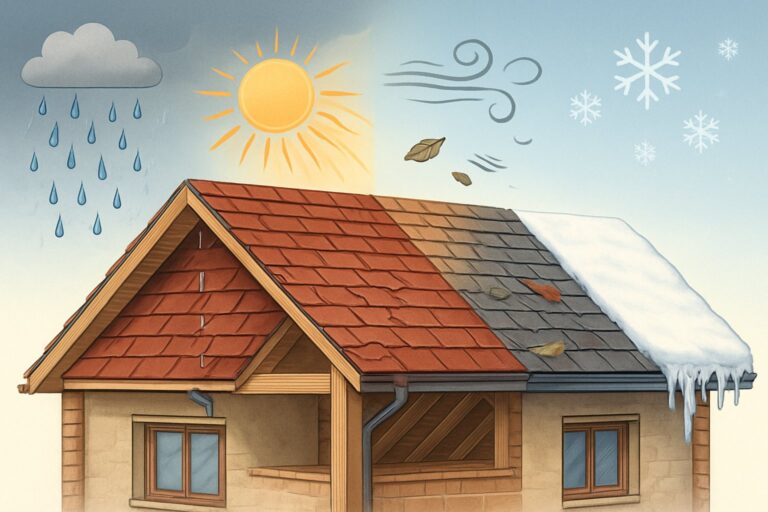
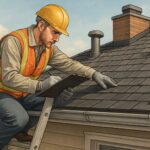


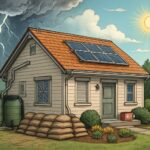
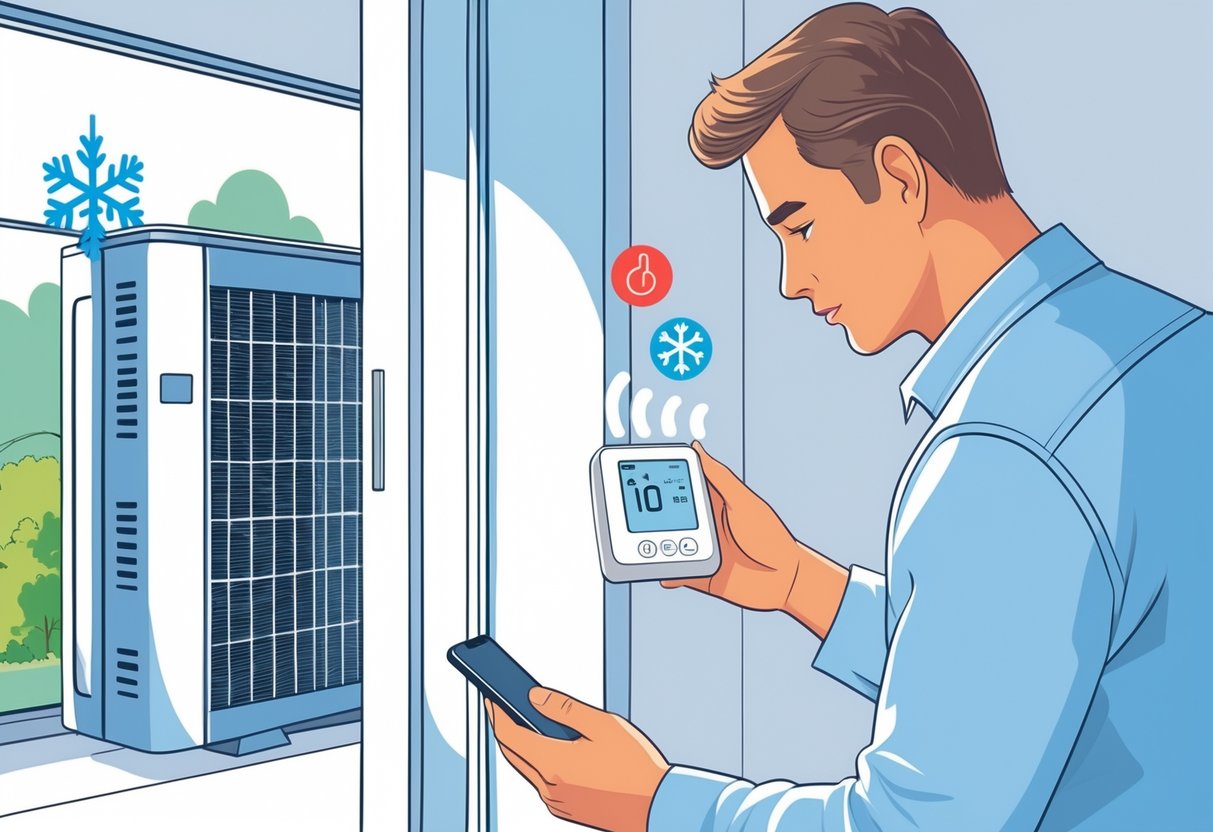
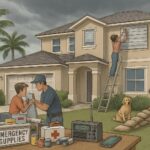
Leave a Reply